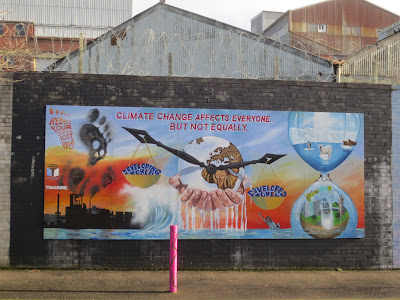I'm a little under the weather today so I thought I would update this bad boy to let anyone readin' know what my status is. I've got a
real post in the works on Microsoft Word, one that describes a little bit more profoundly our stay in Belfast. I hope I can go into a little more detail and analysis of some of the things we saw while we were there.
So obviously, I just got back from Ireland on Monday, Feb. 18th. I spent two days in Dublin and one day in Belfast with my good friend Pete T., and then when he left for the airport on Saturday I headed over to Galway by my lonesome. I hung out in Galway for a night and met some good people there, including a couple infantrymen from the Maltese army, a nice couple from Minnesota, a party-animal from Australia (there are no shortage of this species in hostels throughout the world), and a fellow distinguished metalhead from Belfast. We went out and heard good tunes and shared a few laughs.
I went and saw beautiful Connemara the next day. This is the wild west of Ireland, full of peat bogs, rolling desolate mountains. It's been the setting of countless films through out the years. But make no mistake, it has seen its share of suffering and battering and toil.
It is famine land - one of the worst-hit parts of Ireland when the potato blight sunk its claws into the Emerald Isle in the early 1800s. Over one million left the country. Over one million died or were displaced. It is harsh land, but enrapturing and beautiful.
Take a look at Galway and Connemara.
 |
| This is actually Dublin. Lied a little bit. |
 |
| So is this. Lots of Polish people in Dublin! |
 |
| I went to a real peat bog! |
 |
| This is the bridge from "The Quiet Man". Haven't seen the film though. |
 |
| Lough in Connemara |
 |
| Kylemore Abbey in County Galway |
 |
| I like the palm trees plus the Irish and EU flags |
 |
| Why is she always so sad? |
 |
| Ireland has fjords too! |
 |
| Fairy tree aside the fjord. You tie a ribbon to it and make a wish. Apparently fairies are there to grant them for you. |
 |
| Lough Corrib, County Mayo |
 |
| Whiskey bottle. Green fields. Ireland. |
 |
| Book of Kells Exhibition, Trinity College, Dublin |
 |
| St. Stephens Green, Dublin |
 |
| Keep Off The Damn Fields, You Damn Gaelic Speaking Ruffians |
Ireland is indeed a beautiful place. Now I see what all those longing, lonesome singers were singing about.
I'll go into more depth here in a little bit. At least I hope I will. That's the plan!
My next trip, which is happening during the ridiculous two full weeks we get off for Easter here in Spain, is to: Cluj Napoca, Transylvania, Romania; Budapest, Hungary; Kraków, Poland; and Warsaw, Poland. I'm going to see Dracula (and hopefully some of Romania's many bears - biggest bear population in Europe!), where Liszt wrote music (hopefully), and many, many beautiful cathedrals and buildings.
But I'm maybe the most anxious about seeing and learning the history of Eastern and Central Europe and its peoples, specifically with relation to the 20th century and its great turbulence. I had originally written "excited to see", but I feel that "anxious" is a better word here. Being someone from outside, from the safety and security and stability of the USA, I don't think it's right for me to say I'm "excited" to see Auschwitz, that I'm pumped up to see evidence of war and oppression and conflict, especially one that I was distant from, not even yet born, that I was never at risk to see or experience.
It's similar to how I felt about Belfast. It started as a somewhat morbid curiosity, but quickly turned into respectful and reverent fascination. After seeing the Peace Walls and the memorial murals, I can't and will not ever again joke around about the conflict in Northern Ireland.
In a similar way, I want to see for myself the scars and stories and sweeping landscapes of
europa oriental.
Please don't take it the wrong way, but it's something I need to do. I have to.






















































